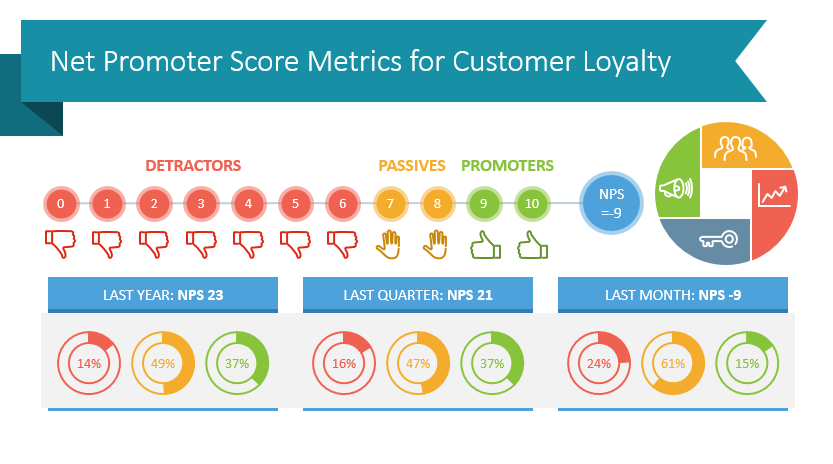Customer loyalty is the bedrock of any successful business. Net Promoter Score (NPS) is a powerful metric used by companies worldwide to measure and enhance this loyalty. This article delves into the intricacies of NPS, its significance, how to implement it effectively, and its impact on customer relationships.
What is Net Promoter Score (NPS)?
Net Promoter Score (NPS) is a management tool that quantifies customer loyalty by asking a single, straightforward question: “How likely are you to recommend our company/product/service to a friend or colleague?”Respondents answer on a scale of 0 to 10, and their responses categorize them into three groups:
- Promoters (9-10): Loyal enthusiasts who will keep buying and refer others, fueling growth.
- Passives (7-8): Satisfied but unenthusiastic customers who are vulnerable to competitive offerings.
- Detractors (0-6): Unhappy customers who can damage your brand through negative word-of-mouth.
How NPS is Calculated
To calculate your NPS, subtract the percentage of Detractors from the percentage of Promoters:
NPS = % Promoters - % DetractorsThis score can range from -100 (if every customer is a Detractor) to +100 (if every customer is a Promoter).
NPS is more than just a number – it’s a crucial indicator of customer loyalty. Studies have shown that companies with high NPS scores tend to have more loyal customers who are likely to return for repeat purchases and refer others to the business. In fact, research has found a clear link between high NPS scores and increased business growth and profitability.
Steffi’s Blogs
Simple NPS Calculator
NPS Calculator
The Importance of NPS
Simple and Intuitive
NPS is lauded for its simplicity and intuitiveness. Unlike complex customer satisfaction surveys, NPS asks just one question, making it easy for customers to respond and for companies to analyze.
Predictive Power
NPS is not just a measure of customer satisfaction; it predicts future business growth. Research shows that companies with higher NPS scores tend to grow faster than their competitors.
Benchmarking Tool
NPS allows for benchmarking both internally and externally. Companies can compare their scores against industry standards and identify areas for improvement.
Actionable Insights
NPS provides actionable insights into customer loyalty. By following up with customers, companies can understand the reasons behind their scores and take steps to enhance the customer experience.
Implementing NPS in Your Business
Step 1: Designing the NPS Survey
While the core NPS question is fixed, you can customize the survey by adding follow-up questions like:
- “What is the primary reason for your score?”
- “How can we improve your experience?”
These questions help gather qualitative data to complement the quantitative NPS score.
Step 2: Distributing the Survey
Effective distribution is key to getting a high response rate. Consider the following methods:
- Email Surveys: Common and effective for reaching a broad audience.
- In-App Surveys: Ideal for software companies, capturing feedback at the point of experience.
- SMS Surveys: Useful for quick, on-the-go responses.
Step 3: Analyzing the Results
Once you’ve collected the responses, analyze the data to identify trends and patterns. Segment the responses by customer demographics, purchase history, or other relevant criteria to gain deeper insights.
Step 4: Taking Action
The real value of NPS lies in the actions you take based on the feedback. Develop a plan to address the issues raised by Detractors and enhance the experiences of Promoters. Regularly update your customers on the changes you’re implementing based on their feedback.

Image courtesy of via Google Images
Best Practices for Maximizing NPS
Regular Surveys
Conduct NPS surveys regularly to track changes in customer sentiment over time. Quarterly or bi-annual surveys are common intervals.
Closed-Loop Feedback
Implement a closed-loop feedback process where you follow up with respondents to understand their feedback better and address their concerns.
Employee Engagement
Engage your employees in the NPS process. Share the scores with them and involve them in brainstorming sessions to improve customer experiences.
Customer Segmentation
Segment your NPS data by different customer groups to identify which segments are most loyal and which need more attention.
Sharing NPS Across the Organization
Ensure that NPS data is shared across all departments. Customer feedback should inform not only the customer service team but also marketing, sales, and product development.
For businesses, understanding and improving NPS can lead to enhanced customer relationships, increased word-of-mouth referrals, and ultimately, higher revenue. Companies like Apple, Amazon, and Southwest Airlines have successfully used NPS to drive customer satisfaction and loyalty, demonstrating the power of this metric in shaping business success.
Steffi’s Blogs
The Impact of NPS on Business Growth
Customer Retention
High NPS scores correlate with higher customer retention rates. Loyal customers are less likely to switch to competitors and more likely to continue purchasing from you.
Word-of-Mouth Referrals
Promoters are your brand advocates. They generate positive word-of-mouth, which is one of the most powerful marketing tools.
Reduced Marketing Costs
With a strong base of loyal customers, you can reduce spending on customer acquisition. Promoters bring in new customers at no additional cost.
Increased Revenue
Companies with high NPS scores typically see higher revenue growth. Loyal customers tend to spend more over time and are less price-sensitive.
Case Studies: Companies Excelling with NPS
Apple
Apple is renowned for its high NPS scores. The company’s commitment to exceptional customer experiences has built a loyal customer base that continues to drive its growth.
Amazon
Amazon’s relentless focus on customer satisfaction is reflected in its consistently high NPS scores. The company’s customer-centric approach has made it a global leader in e-commerce.
Tesla
Tesla’s high NPS is a testament to its innovative products and exceptional customer service. The company’s loyal customer base is a key factor in its rapid growth.
Frequently Asked Questions (FAQs)
Q: How often should I conduct NPS surveys?
A: Conduct NPS surveys at least quarterly to keep track of customer sentiment and identify trends over time.
Q: What is a good NPS score?
A: An NPS score above 50 is considered excellent. However, what’s considered good can vary by industry.
Q: How can I improve my NPS score?
A: Focus on understanding the reasons behind your scores and take actionable steps to address customer concerns. Engage with your customers regularly and ensure their feedback informs your business decisions.
Q: Can NPS be used in any industry?
A: Yes, NPS is a versatile tool that can be applied across various industries to measure and improve customer loyalty.
Q: What should I do if my NPS score is low?
A: If your NPS score is low, prioritize understanding the pain points of your Detractors and take immediate steps to address their concerns. Implement a closed-loop feedback system to ensure continuous improvement.
In Conclusion
Net Promoter Score (NPS) is an invaluable tool for measuring and enhancing customer loyalty. By implementing NPS effectively, companies can gain deep insights into their customer relationships, drive business growth, and build a loyal customer base. Embrace NPS as a core part of your customer feedback strategy and watch your business thrive.
Do you have any questions about NPS or want to share your experiences with implementing it in your business? Leave a comment below or share this article with your network!
References
By following these guidelines and incorporating NPS into your business strategy, you can enhance customer loyalty, drive growth, and ensure long-term success.



